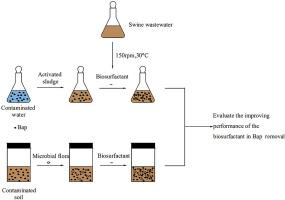Ecotoxicology and Environmental Safety ( IF 6.2 ) Pub Date : 2020-09-09 , DOI: 10.1016/j.ecoenv.2020.111292 Junyuan Guo 1 , Xiaoying Wen 1

|
As a hydrophobic pollutant, benzo(a)pyrene (BaP) is difficult to be degraded by microbes due to its poor water solubility. To improve its water solubility, this study harvested a biosurfactant from swine wastewater. The role of the biosurfactant in BaP biodegradation in contaminated water and soil were investigated. The biodegradation kinetics of BaP in contaminated water and the improvement of soil properties were determined. Results showed that critical micelle concentration (CMC) of the biosurfactant was 46.8 mg/L. The biosurfactant has a high pH stability in range of 3–9 and a strong salt stability in NaCl concentration range of 0–20%. At concentrations of 1, 2, 3, 4 and 5 CMC, the biosurfactant increased BaP water solubility by 1.4, 2.6, 4.0, 5.2 and 6.6 times. BaP biodegradation in contaminated water was effectively promoted by the biosurfactant, and the concentrations of BaP in sludge phase decreased to 1.015 mg/L (47.9% decrement) and 0.675 mg/L (65.4% decrement) when the dosed biosurfactant were 1 and 3 CMC, respectively. The biodegradation kinetics of BaP in contaminated water by the biosurfactant fitted well with the two-compartment kinetic model well (R2 > 0.90). For the bioremediation of BaP contaminated soil, adding 0.1%–0.5% (w/w) biosurfactant biodegraded 39.2%–84.8% of BaP, while the control without biosurfactant was 24.2%. In addition, the application of the biosurfactant significantly improved the properties of the contaminated soil, behaved as the increase in microbial quantity, water holding capacity (WHC) and dehydrogenase (DH) activity of the soil. To sum up, the biosurfactant facilitated the BaP biodegradation and can be effectively used in in–site remediation of polycyclic aromatic hydrocarbons (PAHs) (BaP in this study) contaminated water and soil.
中文翻译:

苯并(a)re在受污染的水和土壤中的生物降解性能和动力学,以及通过生物表面活性剂改良剂改善土壤特性的过程。
作为疏水性污染物,苯并(a)re(BaP)由于水溶性差,很难被微生物降解。为了提高其水溶性,本研究从猪废水中收集了一种生物表面活性剂。研究了生物表面活性剂在被污染的水和土壤中BaP生物降解中的作用。测定了BaP在污水中的生物降解动力学和土壤性质的改善。结果表明,该生物表面活性剂的临界胶束浓度(CMC)为46.8 mg / L。生物表面活性剂在3–9的范围内具有较高的pH稳定性,在0–20%的NaCl浓度范围内具有较强的盐稳定性。在1、2、3、4和5 CMC的浓度下,生物表面活性剂使BaP的水溶性增加了1.4、2.6、4.0、5.2和6.6倍。生物表面活性剂有效地促进了污水中BaP的生物降解,当剂量为1和3 CMC时,污泥相中BaP的浓度分别降至1.015 mg / L(减少47.9%)和0.675 mg / L(减少65.4%)。 , 分别。装有两室动力学模型井的生物表面活性剂将BaP在污水中的生物降解动力学(R 2 > 0.90)。对于BaP污染土壤的生物修复,添加0.1%–0.5%(w / w)的生物表面活性剂可生物降解BaP的39.2%–84.8%,而不含生物表面活性剂的对照为24.2%。此外,生物表面活性剂的应用显着改善了被污染土壤的特性,表现为土壤微生物量,持水量(WHC)和脱氢酶(DH)活性的增加。综上所述,该生物表面活性剂促进了BaP的生物降解,可有效用于现场修复受污染的水和土壤中的多环芳烃(PAHs)(本研究中为BaP)。











































 京公网安备 11010802027423号
京公网安备 11010802027423号